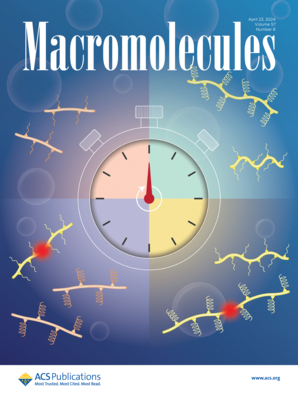Structures and Segmental Dynamics in Single-Chain Polymer Nanoparticles-Based All-Polymer Nanocomposites
IF 5.1
1区 化学
Q1 POLYMER SCIENCE
引用次数: 0
Abstract
All-polymer nanocomposites are attracting dramatic attention due to their unique mechanical and viscoelastic properties. In this study, via multiscale solid-state nuclear magnetic resonance (NMR) methods, it is clearly revealed that a polystyrene (PS)-based single-chain polymer nanoparticle (SCNP) is in closer proximity with linear poly(vinyl methyl ether) (PVME) chains compared to linear PS chains, leading to dramatically different phase separation structures as demonstrated by 1H spin diffusion NMR experiments. High-resolution solid-state 1H NMR spectroscopy at ultrafast magic-angle-spinning (MAS) beyond 90 kHz directly reveals the subtle difference in proximity as well as the hydrogen bonding interactions between PVME and PS (or PS-SCNP) at a molecular level. Due to closer proximity between the PS-SCNP and PVME, the segmental dynamics of PVME is also slowed down by its hydrogen bonding interactions with PS-SCNP as revealed by variable-contact-time cross-polarization (CP) experiments. Particularly, 1H fast field cycling NMR experiments at variable temperatures clearly reveal the enhanced glassy and Rouse dynamic heterogeneity of PVME in the PS-SCNP/PVME blend. To the best of our knowledge, this is the first study to apply solid-state NMR spectroscopy to reveal the sophisticated interplay of structures and segmental dynamics in all-polymer nanocomposites at a molecular level, obtaining consistent results with molecular simulations, which could be helpful for the fundamental understanding of the unusual viscoelastic behaviors of all-polymer nanocomposites.

单链聚合物纳米颗粒基全聚合物纳米复合材料的结构和片段动力学
全聚合物纳米复合材料因其独特的力学性能和粘弹性而备受关注。本研究通过多尺度固体核磁共振(NMR)方法清楚地揭示了基于聚苯乙烯(PS)的单链聚合物纳米颗粒(SCNP)与线性聚苯乙烯(PS)链相比更接近线性聚苯乙烯(乙烯基甲基醚)(PVME)链,从而导致1H自旋扩散NMR实验证明了截然不同的相分离结构。在超过90 kHz的超快魔角旋转(MAS)下,高分辨率固态1H核磁共振光谱直接揭示了PVME和PS(或PS- scnp)在分子水平上的接近性和氢键相互作用的细微差异。变接触时间交叉极化(CP)实验表明,由于PS-SCNP与PVME的距离更近,PVME与PS-SCNP的氢键相互作用也减慢了PVME的片段动力学。特别是,变温度下的1H快速场循环核磁共振实验清楚地揭示了PS-SCNP/PVME共混物中PVME的玻璃态和Rouse动态非均质性增强。据我们所知,这是第一次应用固态核磁共振波谱在分子水平上揭示全聚合物纳米复合材料中结构和段动力学的复杂相互作用,并获得与分子模拟一致的结果,这有助于从基础上理解全聚合物纳米复合材料的不同寻常的粘弹性行为。
本文章由计算机程序翻译,如有差异,请以英文原文为准。
求助全文
约1分钟内获得全文
求助全文
来源期刊

Macromolecules
工程技术-高分子科学
CiteScore
9.30
自引率
16.40%
发文量
942
审稿时长
2 months
期刊介绍:
Macromolecules publishes original, fundamental, and impactful research on all aspects of polymer science. Topics of interest include synthesis (e.g., controlled polymerizations, polymerization catalysis, post polymerization modification, new monomer structures and polymer architectures, and polymerization mechanisms/kinetics analysis); phase behavior, thermodynamics, dynamic, and ordering/disordering phenomena (e.g., self-assembly, gelation, crystallization, solution/melt/solid-state characteristics); structure and properties (e.g., mechanical and rheological properties, surface/interfacial characteristics, electronic and transport properties); new state of the art characterization (e.g., spectroscopy, scattering, microscopy, rheology), simulation (e.g., Monte Carlo, molecular dynamics, multi-scale/coarse-grained modeling), and theoretical methods. Renewable/sustainable polymers, polymer networks, responsive polymers, electro-, magneto- and opto-active macromolecules, inorganic polymers, charge-transporting polymers (ion-containing, semiconducting, and conducting), nanostructured polymers, and polymer composites are also of interest. Typical papers published in Macromolecules showcase important and innovative concepts, experimental methods/observations, and theoretical/computational approaches that demonstrate a fundamental advance in the understanding of polymers.
 求助内容:
求助内容: 应助结果提醒方式:
应助结果提醒方式:


